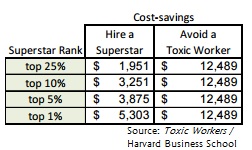Editor’s Note: It’s an annual tradition for TLNT to count down the most popular posts of the previous 12 months. We’re reposting each of the top 30 articles through January 2nd. This is No. 20 of 2017. You can find the complete list here.
∼∼∼∼
I am done. I resigned last week but will stay on through the first of the year. 4 CEOs in 4 years. The atmosphere is blame all around. Any situation that pops up, everyone looks as to who do we blame. They just brought in a new CHRO who was about change and he has been cowered till he just stays in his office all day. The word is that he is already looking. I do not have a job but I know that I can’t take this any longer.
Before I left for the holidays, I had this conversation with a senior level HR officer who was approached for the CHRO role, but decided that he had had enough.
Toxic culture, toxic workers
All actions within an organization send a signal that permeates the entire soul of the organization. When leaders act out it can have a devastating effect throughout. Who wants to work in a dysfunctional organization? No one if they can help it.
Harvard University published a study by Michael Housman and Dylan Minor called Toxic Workers. They reasoned that talented and productive people who engage in harmful and negative behavior can hurt your culture as well as your bottom line.
Nicole Torres wrote about it in her report titled “It’s Better to Avoid a Toxic Employee than Hire a Superstar” over at Harvard Business Review: Avoiding a toxic employee can save a company more than  twice as much as bringing on a star performer. Avoiding a toxic worker was worth about $12,500 in turnover costs, but even the top 1% of superstar employees only added about $5,300 to the bottom line.
twice as much as bringing on a star performer. Avoiding a toxic worker was worth about $12,500 in turnover costs, but even the top 1% of superstar employees only added about $5,300 to the bottom line.
If that’s not a wake-up call to your C-suite and board, I don’t know what is. But what is always amazing to me is that many organizations just sweep these problems under the rug and move on. I suppose the thought is that if we ignore it, it will go away. Like smoke in the air, it will eventually dissipate. However, within an organization, that will never happen. That dissipation just permeates the soul like seasoning.
Leaders set the culture
There use to be a time that people left bad managers, but what I am seeing a lot of now is people leaving bad cultures. When you have created a toxic environment, it decreases engagement, increases turnover, and creates other ills in the organization. I used the phrase “creating a toxic environment” because my thought is that if leaders do not step up to build a sustainable culture, you have created this monster.
Senior leaders are the visible face of the organization. Their duty is to set strategic and cultural goals, and steer the company in the right direction to achieve their vision. Through positive attitudes and actions, they can build a culture that involves and inspires all employees.
Sixty percent of employees who have confidence in the abilities of senior leaders and think that senior leaders are moving the organization in the right direction are fully engaged. Employees want to be able to voice their opinions and to know that their opinions matter. Unsurprisingly, employees who say their company encourages open and honest communication are more engaged. They welcome the opportunity to share concerns and work together to find solutions.
When employees feel they lack opportunities to express opinions or the environment has become toxic so they feel their voice is unheard, they tend to become unmotivated and start looking for the door.
Senior leaders can further generate engagement in the workplace by promoting a spirit of teamwork and cooperation amongst themselves. This positive peer interaction at the senior level allows employees to witness a success model that should trickle down within the organization.
Your culture can make or break you
Leaders must set the example and be just as concerned about culture as they are about the strategy within. Organizations whose strategy is at odds with their culture should think twice, as it’s easier to change strategies than to change culture. My friend’s company has tremendous growth plans that it can’t get off the ground; the culture is eating it alive.
However, sometimes culture change is the right choice to make. If the culture is full of unhealthy practices, success will be difficult with any strategy. In this case, pursuing the hard work of culture change is paramount for long-term success. And there are times when a strategy is so compelling that to not evolve the culture to fit it is just plain short-sighted.
Engagement starts at the top
The cascade effect means that if the heads of the organization are committed to building the right culture, it will cascade like a waterfall. Every study of companies with strong financial results shows they share one distinguishing feature: That is the quality of their senior management. If the senior managers’ levels of engagement are high, their ability to engage others in the organization is strong
Building trust and honest communication
In highly engaged organizations, leaders are perceived as significantly more effective than their counterparts at low engagement organizations. These leaders set the right direction and mobilize the workforce. Communication is an important element in building the perception of leader effectiveness. Leaders must communicate the reality of the business and the impact it has on the organization, while recapturing employees’ hearts and minds.
Strong leadership and frequent communication are always important, but they are crucial during difficult times to even maintain employee engagement at current levels, let alone drive it higher. What is really important with respect to leadership communication is that it be frequent and forthright, answering the questions employees are asking.
Senior leaders drive employee engagement
The impact senior leaders typically have on employee engagement does not often show up in the top drivers of employee engagement. But it is senior leaders who are the drivers of a strong culture. Their involvement in building a strong culture demonstrates the organization’s commitment and brings to life initiatives that drive employee engagement.
In the end, if they do not care why should the employees?
